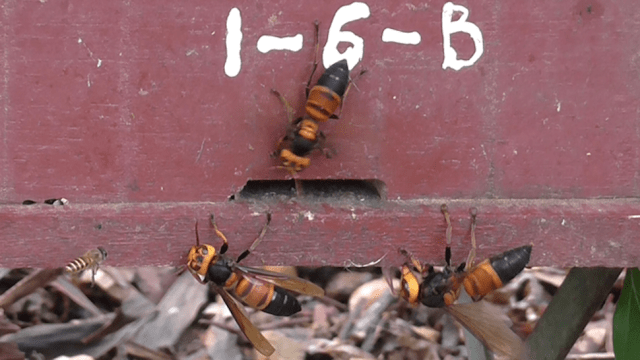Unsettling and distinctive sounds made by Asian honey bees during attacks of giant hornets might be an alarm signal for the hive to deploy defensive measures.
Attacks by giant hornets (Vespa soror) are existential threats to colonies of honey bees (Apis cerana). Their invasions are brutal and practically identical to those employed by their sister species, Vespa mandarinia, popularly known as murder hornets (the two species are very similar in terms of body shape and behaviour, but it’s important to not conflate the two, especially given the invasive potential of V. mandarinia in western North America). Giant hornets, owing to their bulk and ferocity, can devastate an entire bee hive in just a few hours, during which time they kill the defenders, occupy their nest, and — in the ultimate injustice — carry back the defenseless brood as food for their own larvae.
It’s very nasty business, but new research published in Royal Society Open Science shows one potential way in which Asian honey bees have managed to adapt: an alarm call specific to giant hornets.
“It’s alarming to hear!” Heather Mattila, a co-author of the study and a researcher at Wellesley College, told me when I asked her to describe the apparent distress signal. “It’s characterised by rapid bursts of high-pitched sounds that change unpredictably in frequency — they’re quite harsh and noisy.”
Fascinatingly, the alarm shares “acoustic traits with alarm shrieks, fear screams, and panic calls of primates, birds, and meerkats,” according to the study. Mattila said it’s “exciting to learn that the sound properties of the honey bees’ alarm signal are really similar to the properties of signals used by mammals that also live in social groups and share information about danger around them.”
Working with local beekeepers in Vietnam, Mattila and her colleagues have spent the better part of seven years studying the various interactions between Asian honey bees and their arch nemesis, the giant hornets. By placing microphones inside of hives, the team amassed over 1,300 minutes of beehive chatter. The newly detected alarm signal, called an “antipredator pipe,” was isolated from other sounds, including other acoustic bee signals, by looking at visual representations of sound known as spectrograms.
“These images show the different properties of the sounds that the bees make, even if they overlapped in time because many bees were signalling at once,” Mattila explained. “We looked through all of our recordings to get good examples of antipredator pipes that were clear of other sounds so that we could characterise their acoustic properties. Then it became easy to recognise them in more chaotic moments, when lots of sounds were being made.”
By “pipes,” Mattila is referring to sounds made by bees when they vibrate their wings or thorax. The team chose to call it an “antipredator pipe” as the signal appears to be linked exclusively to attacks of giant hornets.
That said, the scientists aren’t entirely sure if or how the alarm signal alters the bees’ behaviour. What they do know, however, is that hive chatter increases eight-fold during a hornet attack and that bees begin to gather outside the hive entrance once the antipredator pipes have been sounded.
The bees then deploy a series of defensive measures, such as caking the entrance with animal dung, which repels the hornets. Working together, some bees will form a smothering ball around the hornets, which kills the attackers through overheating and asphyxiation. The bees also emit pheromones through their Nasonov gland, the purpose of which remains vague, though it may facilitate clustering behaviour.
These preliminary observations are very exciting, and they set the stage rather nicely for future research.
“We still need to do playback experiments, where we play these sounds to colonies that aren’t being attacked by hornets, and then see what they do,” Mattila said. “That would let us know the specific reaction of the bees to these pipes. Currently, we know that the signals and defences happen at the same time, but it is not clear which ones start the others.”
In terms of limitations, and as noted, the scientists still need to determine if the alarm is altering the colony’s behaviour, such as triggering specific calls to action. Also, the team studied only one species of Asian honey bee, so it’s not clear if other Asian honey bees are producing the same signals. “We also have no idea whether Apis mellifera, the honey bee used by most beekeepers around the world, would respond the same way,” as most “have no natural contact with hornets,” said Mattila.
At the same time, she said it’s “fascinating to learn that bee signals can be so specific, too,” and she hopes “people will appreciate just how complicated the honey bee’s world is, and how well they are equipped to react moment-to-moment to the threats they face.”
